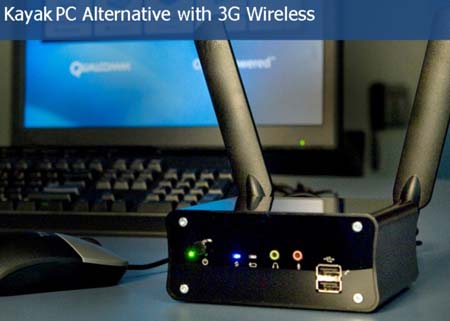Qualcomm's Kayak "PC alternative" pictured

Here's a picture of Kayak, the "PC alternative" for emerging markets that Qualcomm announced yesterday. It looks pretty much the way the company described it: sort of a cross between the Apple Mac Mini--bring your own monitor, keyboard and mouse--and the OLPC's XO laptop with its rabbit-ear antennae.
Kayak has received a lot of coverage in the past 24 hours (here's the Kayak press release), but it's a bit misleading. Qualcomm isn't going to start building netbooks. This device is a prototype that Qualcomm is demonstrating today at its analysts' day in New York. The company hopes PC manufacturers, or more likely wireless carriers, will use this Kayak design to quickly build their own low-cost devices for markets such as India, China and South America using Qualcomm's chips.
Nevertheless the concept is interesting. Qualcomm is essentially betting that expertise in wireless will trump expertise in PC hardware and software when it comes to connecting the rest of the world to the Internet. Given the number of handset and the growth of 3G in all parts of the world--709 million subscribers growing to 1.6 billion by 2012--they could have a point.
So what exactly is the Kayak? The design is based on Qualcomm's MSM 7000 series chipset, which is a highly-integrated chipset currently used in many smartphones such as T-Mobile's G1 with Google's Android. Obviously one key difference compared to the XO laptop or Intel Classmate PC is that Qualcomm's chipset includes wireless wide-area networking--both on CDMA2000 and WCDMA networks. It also uses Qualcomm's Brew software platform and a version of the Opera browser for running Web-based applications. Kayak devices will also be capable of digital music playback and some level of 3D gaming.
The chipset uses an ARM application processor so it can't run Windows applications, but like Linux-based netbooks, Kayak devices could run existing productivity suites and support some Office file formats. "Long-term we would welcome the opportunity to port any of the Windows applications and we've had numerous discussions with Microsoft on this, but we don't have anything to announce at this point," CEO Dr. Paul Jacobs said at the meeting today. He added that Qualcomm has worked with Adobe to support Flash applications on Brew, which should make it easier to quickly develop applications.
Inventec, a contract manufacturer in Taiwan, will manufacture initial Kayak devices for trials in first quarter of 2009 in Southeast Asia. Qualcomm says Kayak-based devices will cost less than $400, but carriers could also subsidize the cost with a contract--a trend that's already emerging with netbooks in Western Europe and Japan. Eventually Qualcomm may shift the Kayak design to its more powerful Snapdragon processor, which is primarily designed for netbooks and should start showing up in a few devices next year.
